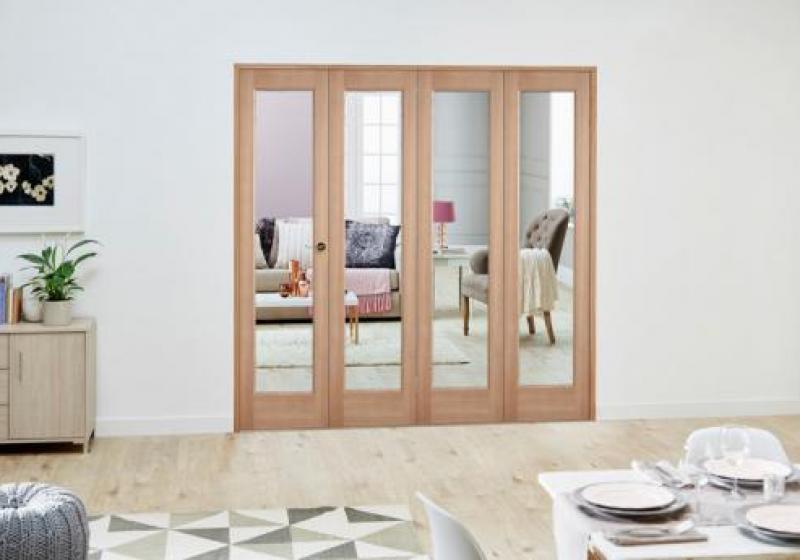
Bifolding doors aren't just meant for the patio or garden, having sliding or folding doors inside the house can be a stylish and contemporary way to conjoin two main living areas into a larger space to play, work and enjoy. There are many designs to choose from on the market, and knowing which of the different types of folding door are right for your home can be a minefield. To make life that little bit easier, we've put together a guide that you can read in your own time of the most common questions we get asked from our customers.

Our door range is all manufactured to the same standard size, which is 2074mm. They can be trimmed from the manufacturing standard to 2040mm and anything in between. This enables you to order a door safe in the knowledge that they are able to be trimmed should you find yourself with a door that is too large for its intended space. For more detailed information, read our guide to bifold door sizing.
What width you will need will obviously depend on the space you have available, this will determine how many doors you need that will either concertina up together or slide out of the way. You'll need to measure the space that your doors will be going into in your home, which will allow you to begin your search for the perfect door size. If you want to keep costs down, try to find a door that is the perfect size already which will allow you to install them immediately without the extra cost and effort of having to trim them.
The number of interior bifold doors you will need in your door system is a common question that we get asked. Many customers wonder why door systems generally come in uneven numbers with one door being fixed with the other panels either slide or concertina, the reason for this is that it is far more convenient to have one door that always opens rather than to have to open several doors everything to open all the time. Generally, our door systems follow exterior bifold door guidelines and are 3+0, 3+1, 4+1, 5+0, 5+1 and 3+3. The number on the right is generally an indicator of the number of doors that will be in a fixed position - for example, 3+0 is a system that will have simply have three sliding or concertina doors. 3+1 is a system that will have one fixed door and 3 sliding and so on. For more information check our guide on what room dividing doors to choose.
Another important decision to make when you're buying your interior door system is whether or not you want a tracked system or a trackless system.
The popularity of trackless systems is evident. The range doesn't leave a metal track strips or threshold strip, all of the running equipment lies at the top of the door so the overall finish is far more sophisticated and sleek. Tracked systems require a guide track at the bottom of the door system which often can look unsightly.
Door systems with a base track, however, do have their own benefits. The main advantage of a tracked door system is that it can hold a much larger weight, this allows you to choose a door system that has more door leaves, more glass, and wider access doors. This is a preferable option for a larger space that will require more doors to be fitted.
If you opt for a top-hung door system, you will need to ensure that that they are fixed securely to a lintel, steel, or timber section that will hold the weight of the doors. The most common option for this is to install the joining panel into a stud wall opening. A competent joiner should be able to install your doors in a day, allowing for tea breaks of course!
Floor clearance is how much room you will need under your folding doors when you have the frame installed. For example, our range of NUVU roomfold doors allow between 12 and 19mm of clearance underneath your doors for the floor coverings you have in your house – like a thick carpet.
All systems have different clearances that you will need so the best advice we can give you is to check this before you invest in your internal doors. It is important that you check because ultimately it will save you time trimming the underside of your doors once you have them ready to install.

The best way of deciding whether or not you want frosted or clear glass to consider what level of privacy you need or want in the rooms on either side of your doors. Frosted glass obviously gives you a higher level of privacy, and if you have a dining room leading onto a living room, frosted glass might not be a necessity. Clear glass will continue the flow of the room, making them look bigger, lighter, and more attractive to potential buyers should you ever wish to sell your home. Despite the glass you choose, you can always dress your bifold doors to allow you to shut off areas when you need to.
Toughened glass on bifolding doors are always a popular option, they provide additional safety should there ever be an incident in which the glass might be likely to break.
Choosing the right bifolding doors for the interior of your home is a big decision, and knowing which ones are the right ones for your home can be hard when there are so many options. Once you know the size and material that you need, it sets the parameters in which you can then chose the style you need, which whittles options down nicely for you to choose from.
If you still have any queries about bifold doors, why not check our internal bifold door FAQs.
Proud stockists of....
